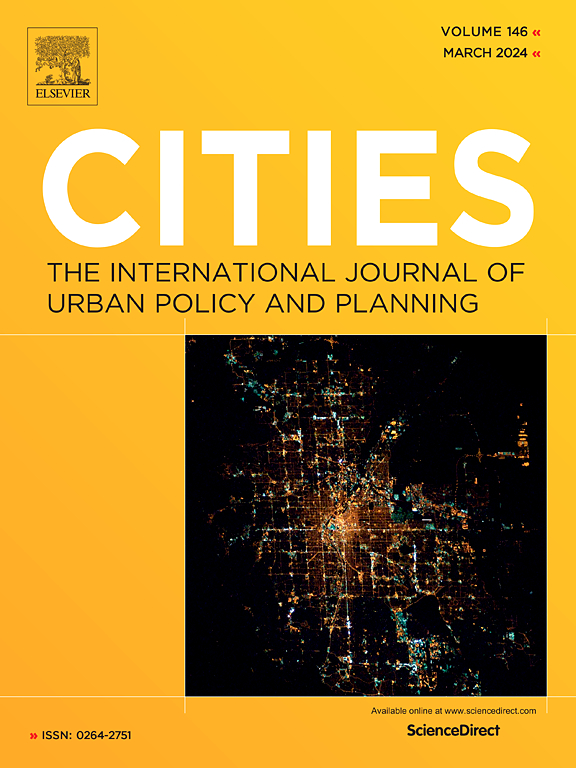数字化物理猎物:Lotka-Volterra模型在城市建筑使用中知识驱动的崩溃
IF 6.6
1区 经济学
Q1 URBAN STUDIES
引用次数: 0
摘要
本文提出并验证了Lotka-Volterra (LV)融毁模型,以探索由居住者知识推动的数字掠夺如何系统地减少或“消耗”工业、办公、零售和住房的足迹。与静态土地使用框架相反,每当占用者的技能超过关键阈值时,无形的使用就会以牺牲物理“猎物”为代价,充当“捕食者”。通过将熔毁分数与结构锚定、数字准备和空缺相结合,我们捕捉到了物理功能的侵蚀和无形领域的兴起。我们使用125年(1900-2025)跨越四个主要使用类别的数据来校准模型,显示居住者的知识如何解释历史变迁-例如工业足迹的崩溃或零售的部分收缩-一旦任务迁移到网上。展望2100年,工业用地几乎消失,零售业严重紧缩,办公用地适度减少,住房份额稳定。至关重要的是,部分再分配适应了历史建筑的改造(例如,工厂的改造)和无形的迁移,表明数字饱和可以在本世纪中叶之后完全在线驱动熔堆流。尽管无形的使用永远不会形成一个普遍的“巨石”——由于固有的模型衰减——知识驱动的数字化可能会急剧加速崩溃,除非现场的独特性或政策干预维持物理类别。通过将居住者的知识投射到Lotka-Volterra捕食者-猎物的框架中,本研究提供了一个新的视角来解释和预测在不断加剧的数字化转型中实体建筑存量的命运。本文章由计算机程序翻译,如有差异,请以英文原文为准。
Digitizing the physical prey: A Lotka–Volterra model for knowledge-driven meltdowns in urban building usage
This paper proposes and validates a Lotka–Volterra (LV) meltdown model to explore how digital predation—fueled by occupant knowledge—systematically reduces or “consumes” industrial, office, retail, and housing footprints. In contrast to static land-use frameworks, intangible usage acts as a “predator” expanding at the expense of physical “prey” whenever occupant skills surpass key thresholds. By embedding meltdown fractions with structural anchoring, digital readiness, and vacancy, we capture the concurrent erosion of physical functions and the rise of intangible domains. We calibrate the model using 125 years (1900–2025) of data spanning four major usage categories, showing how occupant knowledge explains historical shifts—such as the collapse of industrial footprints or partial contractions in retail—once tasks migrate online. Forward scenarios to 2100 suggest near-elimination of Industrial usage, severe Retail retrenchment, modest Office reductions, and a stable Housing share. Crucially, partial reallocation accommodates historical building conversions (e.g., repurposed factories) and intangible migrations, demonstrating that digital saturation can drive meltdown flows fully online after mid-century. Although intangible usage never forms a universal “monolith”—thanks to intrinsic model decay—knowledge-driven digitization may drastically accelerate meltdown unless on-site distinctiveness or policy interventions sustain physical categories. By casting occupant knowledge in a Lotka–Volterra predator–prey framework, this study offers a novel lens to interpret and project the fate of physical building stocks amid intensifying digital transformation.
求助全文
通过发布文献求助,成功后即可免费获取论文全文。
去求助
来源期刊

Cities
URBAN STUDIES-
CiteScore
11.20
自引率
9.00%
发文量
517
期刊介绍:
Cities offers a comprehensive range of articles on all aspects of urban policy. It provides an international and interdisciplinary platform for the exchange of ideas and information between urban planners and policy makers from national and local government, non-government organizations, academia and consultancy. The primary aims of the journal are to analyse and assess past and present urban development and management as a reflection of effective, ineffective and non-existent planning policies; and the promotion of the implementation of appropriate urban policies in both the developed and the developing world.
 求助内容:
求助内容: 应助结果提醒方式:
应助结果提醒方式:


